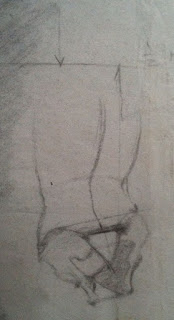I love the silkscreen because you don't need a press, and the play of colors you get from this type of printmaking.
I do a little preliminary work before I begin making the print. Pastels of crayons works best for setting up the image with as few colors as possible. I used four colors in this pastel sketch, white is created by the paper, this make five colors. Now I only need four screens to make the color shapes.
 |
| Four Values of Black and White |
You can read more about these methods from "@"speedball instructions booklet".
I make the first screen color a warm color let it dry then use the same screen to pull a blue over it.
Here is one of the prints, I make several trying different colors to express the image the way I want.
Printmaking in general is a great way to learn about the simple "Notan" design that is essential to good painting.
Notan is the Japanese design concept involving the play and placement of light and dark as they are placed next to the other in art and imagery.
Here is a copy of an Arthur Westley Dow design I used to make a Tee Shirt.
One Screen was used for this print.
I make a few more pulls from my screens before my final pull to see how I want my colors to work in the design. It's important to work from the lighter colors to the darker colors in this method.
In my final pull I used the four screens to make six colors by using two of my screens twice to create the six colors.
Now I can use my screens to make as many prints as I want.












